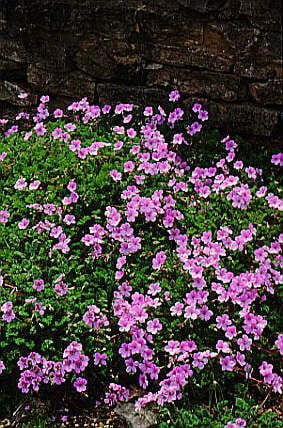Erodium glandulosum
black-eyed heron's bill
A compact herbaceous perennial to 20cm, forming a clump of small, grey-green, oval leaves. Flowers 2.5cm in width, lilac-pink with darker veins

Buy this plant
Size
Ultimate height
0.1–0.5 metresTime to ultimate height
2–5 yearsUltimate spread
0.1–0.5 metresGrowing conditions
Moisture
Well–drainedpH
Alkaline, NeutralColour & scent
| Stem | Flower | Foliage | Fruit | |
| Spring | Green Grey Silver | |||
|---|---|---|---|---|
| Summer | Pink | Green Grey Silver | ||
| Autumn | Green Grey Silver | |||
| Winter |
Position
- Full sun
Aspect
East–facing or South–facing or West–facing
Exposure
Exposed Hardiness
H5Botanical details
- Family
- Geraniaceae
- Native to GB / Ireland
- No
- Foliage
- Deciduous
- Habit
- Clump forming
- Genus
Erodium can be annuals, perennials or subshrubs, some evergreen, with lobed or pinnately divided leaves and bowl-shaped, 5-petalled flowers in summer
- Name status
Correct
How to grow
Cultivation
Grow in gritty, humus-rich, well-drained soil that is neutral to alkaline; needs full sun
Propagation
Propagate by seed in pots in an open frame as soon as seed is ripe. Propagate by division in spring. Propagate by basal stem cuttings in late spring to early summer.
Suggested planting locations and garden types
- Rock garden
- Gravel garden
- Patio and container plants
- Garden edging
Pruning
No pruning required
Pests
Generally pest-free
Diseases
Generally disease-free
Love gardening
Sign up to receive regular gardening tips, inspiration, offers and more
View our Privacy Policy
Get involved
The Royal Horticultural Society is the UK’s leading gardening charity. We aim to enrich everyone’s life through plants, and make the UK a greener and more beautiful place.